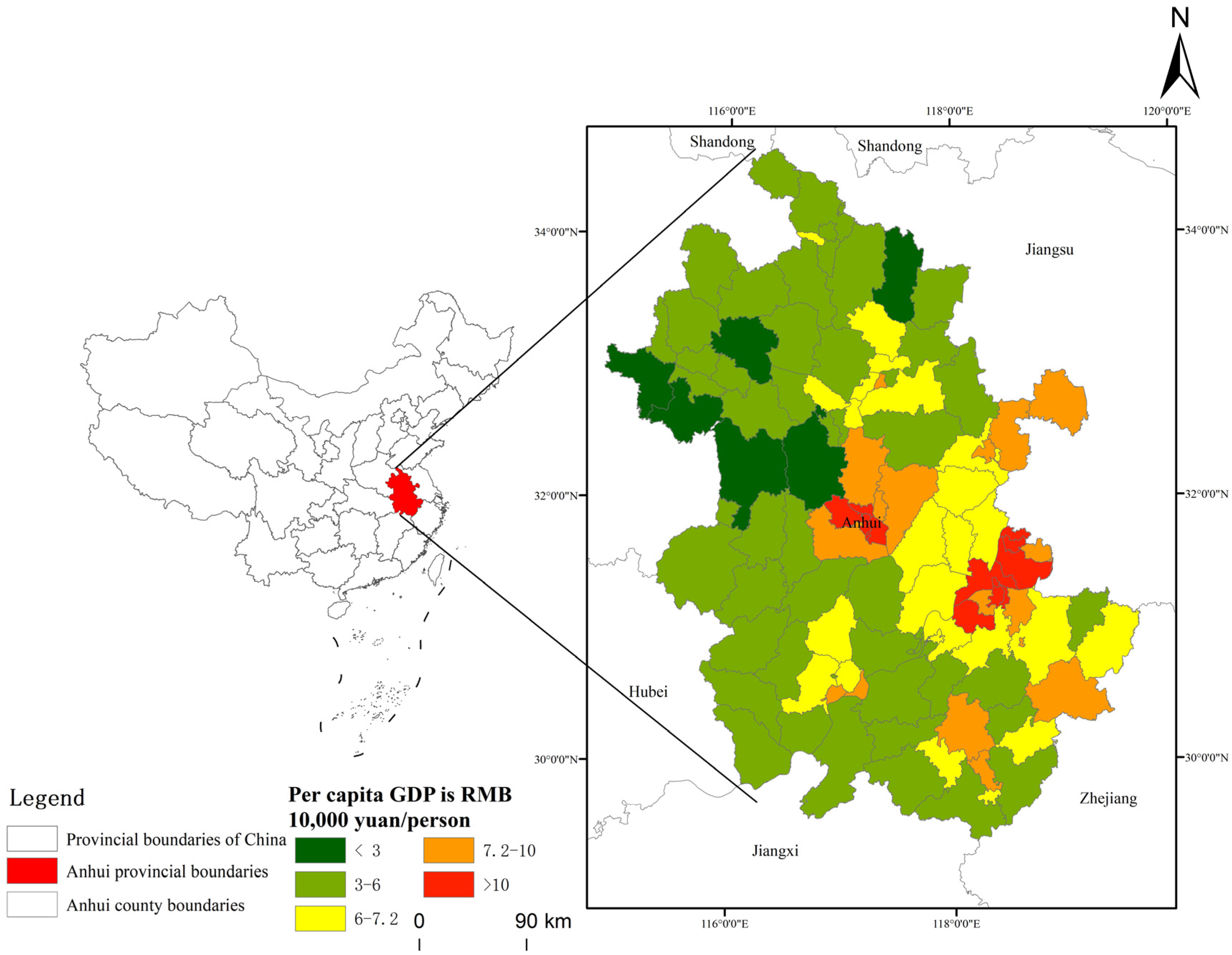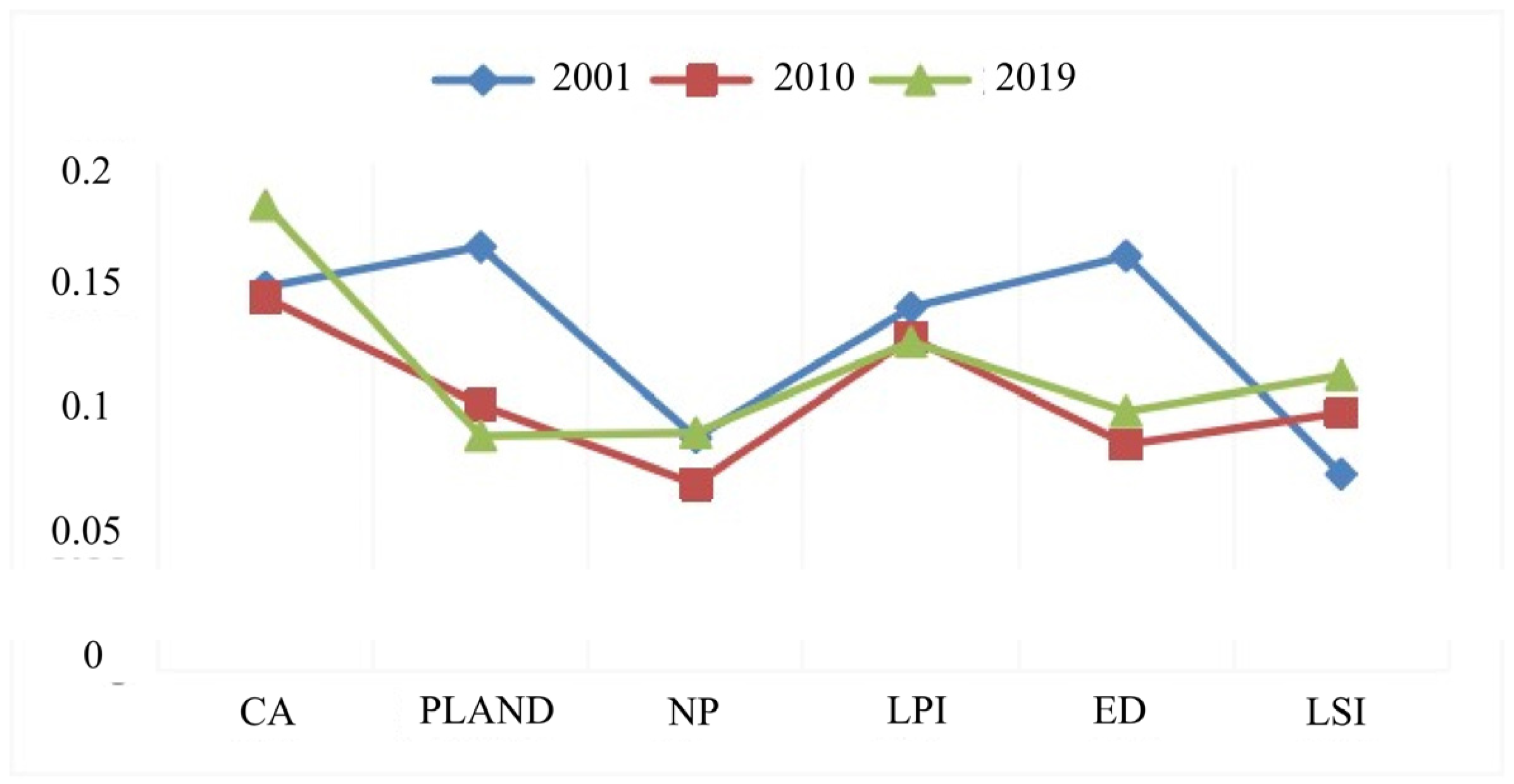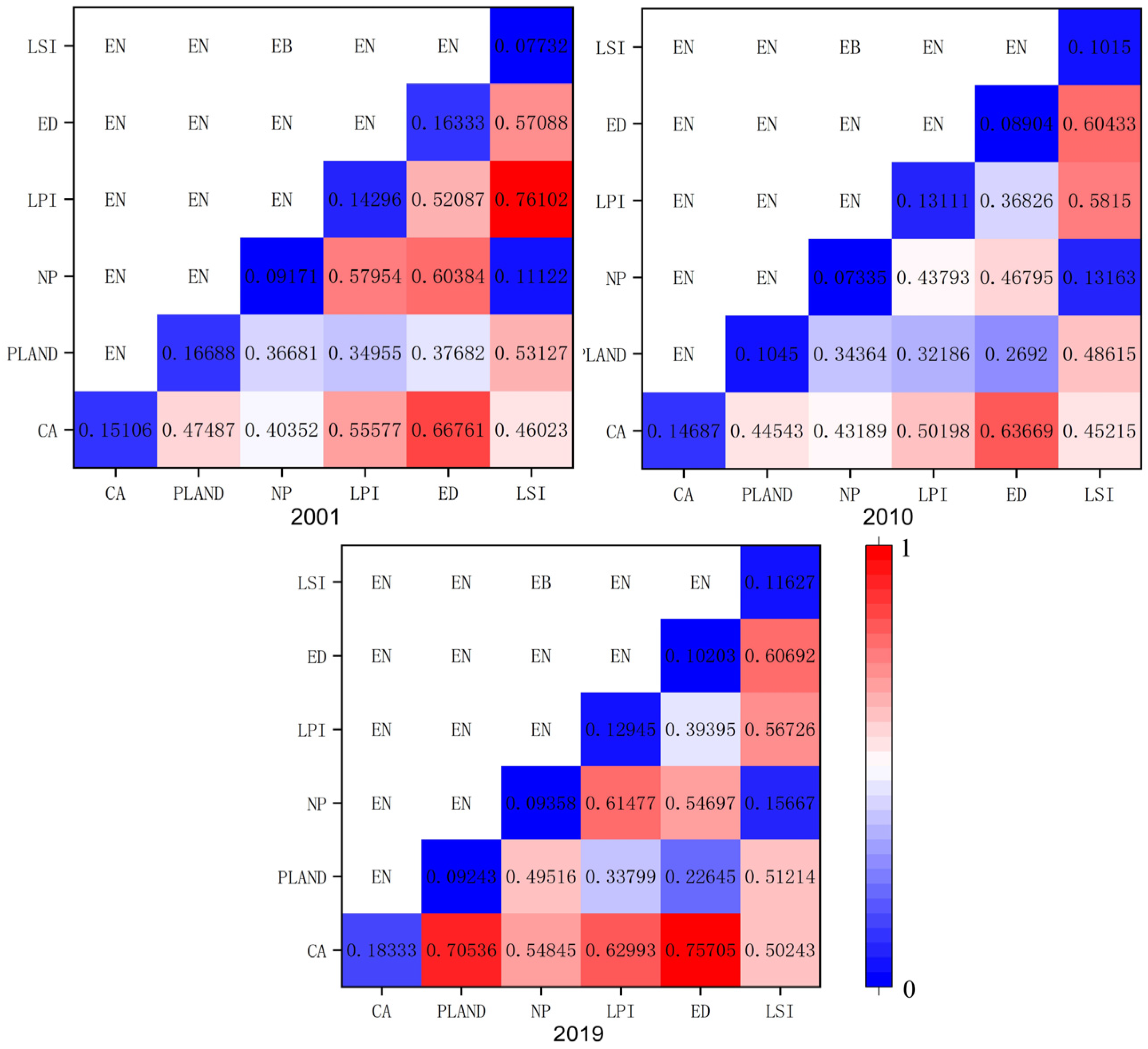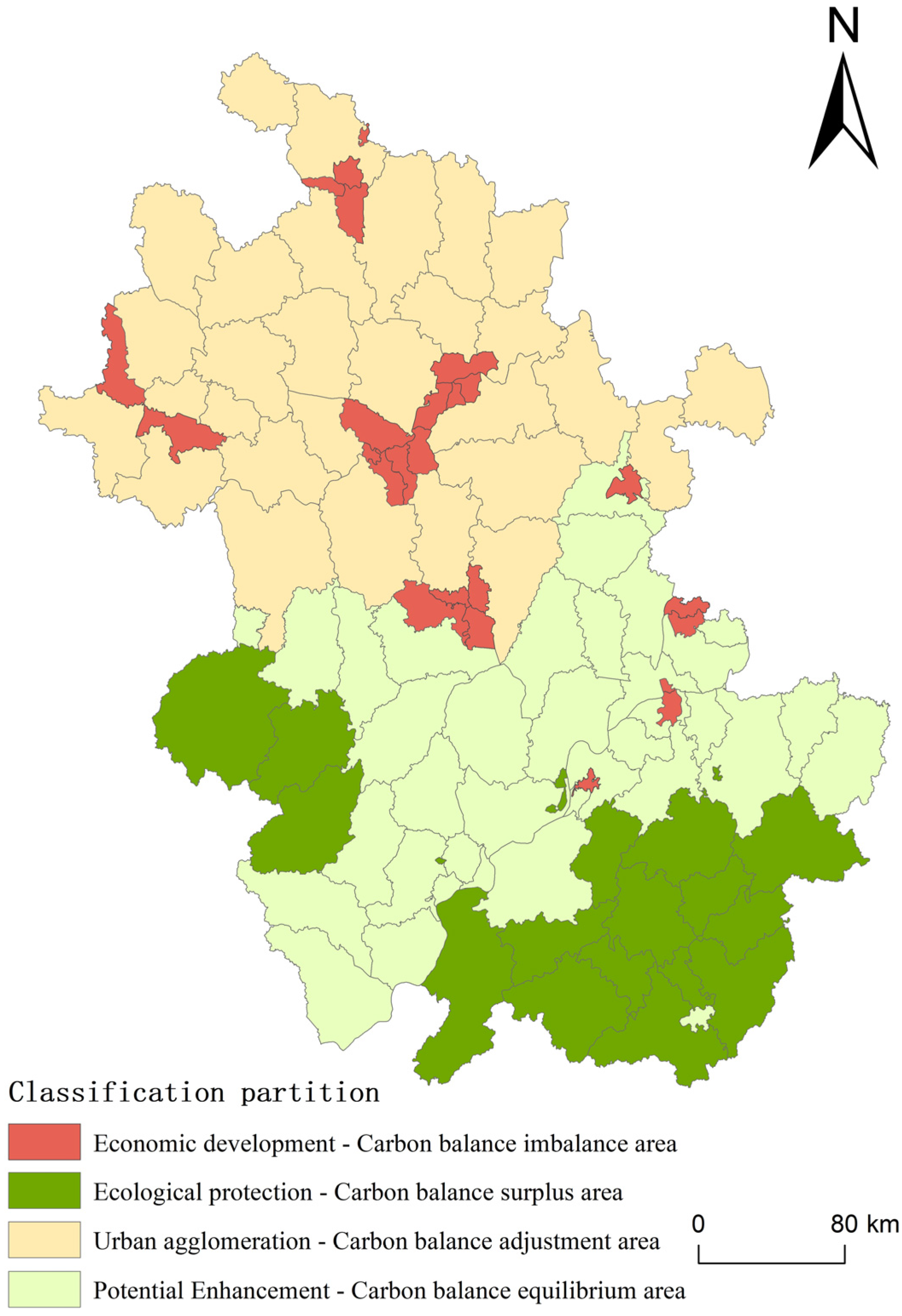Spatio-Temporal Correlation and Optimization of Urban Development Characteristics and Carbon Balance in Counties: A Case Study of the Anhui Province, China
Abstract
:1. Introduction
2. Overview of the Study Area and Data Sources
2.1. Overview of the Study Area
2.2. Data Sources
3. Methods
3.1. Measurement of Carbon Balance
3.2. Analysis of the Characteristics of Urban Spatial Development and Their Spatial–Temporal Evolution
3.2.1. Indicator Selection
3.2.2. Analysis of Spatial and Temporal Evolution of Urban Development Characteristics
3.3. Correlation Analysis between Urban Spatial Development Characteristics and Carbon Balance Degree
- (1)
- GTWR Model
- (2)
- Geodetector model
- (3)
- K-means clustering
4. Results and Analysis
4.1. Analysis of Spatial–Temporal Evolution of Urban Spatial Development Characteristics
4.1.1. Relative Length of Anhui
4.1.2. Curvature of Anhui
4.2. Analysis of the Calculation Results of Carbon Budget Balance in Anhui Province
4.3. Spatial and Temporal Correlation Analysis of Urban Spatial Development Characteristics and Carbon Balance Degree in Anhui Province
4.4. Analysis of the Impact of Urban Spatial Development Characteristics on Carbon Balance
4.5. Zoning Control and Optimization Strategies of Urban Spatial Development Characteristics and Carbon Balance
4.5.1. Optimizing Partitions
4.5.2. Policy Recommendations
5. Discussion and Conclusions
5.1. Discussion
5.1.1. Carbon Balance Accounting and Spatiotemporal Differentiation Characteristics
5.1.2. Correlation Analysis between Urban Spatial Development Characteristics and Carbon Balance in Unbalanced Regions
5.1.3. Impact Mechanism of Urban Spatial Development Characteristics on Carbon Balance
5.2. Conclusions
Author Contributions
Funding
Institutional Review Board Statement
Data Availability Statement
Conflicts of Interest
References
- Lewis, S.L.; Maslin, M.A. Defining the Anthropocene. Nature 2015, 519, 171–180. [Google Scholar] [CrossRef] [PubMed]
- Jin, Y.; Ding, J.; Chen, Y.; Zhang, C.Z.; Hou, X.H.; Zhang, Q.Q.; Liu, Q.K. Urban Land Expansion Simulation Considering the Increasing versus Decreasing Balance Policy: A Case Study in Fenghua, China. Land 2023, 12, 2099. [Google Scholar] [CrossRef]
- Zhang, X.P.; Li, P. Research progress of the impact of built environment on carbon emissions of urban construction land. Sci. Technol. Rev. 2021, 39, 65–74. [Google Scholar]
- Li, H.B.; Jin, X.B.; Han, B.; Xu, W.Y.; Zhou, Y.K. Theoretical research and practical strategy of comprehensive land consolidation under the goal of carbon emission peak and carbon neutrality. Geogr. Res. 2022, 41, 3164–3182. [Google Scholar]
- Tang, X.; Liu, S.; Wang, Y.; Wan, Y.W. Study on carbon emission reduction countermeasures based on carbon emission influencing factors and trends. Environ. Sci. Pollut. Res. Int. 2024, 31, 14003–14022. [Google Scholar] [CrossRef]
- Yang, P.J.; Peng, S.; Benani, N.; Dong, L.Y.; Li, X.M.; Liu, R.P.; Mao, G.Z. An integrated evaluation on China’s provincial carbon peak and carbon neutrality. J. Clean. Prod. 2022, 377, 134497. [Google Scholar] [CrossRef]
- Huang, H.Z.; Jia, J.S.; Chen, D.L.; Liu, S.T. Evolution of spatial network structure for land-use carbon emissions and carbon balance zoning in Jiangxi Province: A social network analysis perspective. Ecol. Indic. 2024, 158, 111508. [Google Scholar] [CrossRef]
- Ronald, G.P.; Yang, X.K.; Wang, S.B. Interacting atmospheres: Global atmospheric biosphere chemistry. AMBIO-J. Hum. Environ. 1994, 23, 50–61. [Google Scholar]
- Friedlingstein, P.; Jones, M.W.; O’Sullivan, M.; Andrew, R.M.; Bakker, D.C.E. Global carbon budget 2021. Earth Syst. Sci. Data 2022, 14, 1917–2005. [Google Scholar] [CrossRef]
- Rogelj, J.; Schaeffer, M.; Meinshausen, M.; Knutti, R.; Alcamo, J.; Keywan, R.; William, H. Zero emission targets as long-term global goals for climate protection. Environ. Res. Lett. 2015, 10, 105007. [Google Scholar] [CrossRef]
- Lin, B.Q.; Benjamin, N.I. Influencing factors on carbon emissions in China transport industry. A new evidence from quantile regression analysis. J. Clean. Prod. 2017, 150, 175–187. [Google Scholar] [CrossRef]
- Allen, M.R.; Frame, D.J.; Huntingford, C.; Jones, C.D.; Lowe, J.A.; Meinshausen, M.; Meinshausen, N. Warming caused by cumulative carbon emissions towards the trillionth tonne. Nature 2009, 458, 1163–1166. [Google Scholar] [CrossRef]
- Christian, H.; Gibran, V. Carbon footprint analysis of household consumption in greater Guadalajara reveal stark socio-spatial inequalities. Ecol. Econ. 2022, 199, 107495. [Google Scholar]
- Moon, S.; Chamberlain, C.P.; Hilley, G.E. New estimates of silicate weathering rates and their uncertainties in global rivers. Geochim. Cosmochim. Acta 2014, 134, 257–274. [Google Scholar] [CrossRef]
- David, P.T.; William, D.R.; Yang, Z.Q.; Robert, E.K.; Warren, B.C.; Maureen, V.D.; Peter, E.T.; Beverly, E.L. Decadal trends in net ecosystem production and net ecosystem carbon balance for a regional socioecological system. For. Ecol. Manag. 2011, 262, 1318–1325. [Google Scholar]
- Roberto, P.; Ramdane, A.; Alessandro, C.; Kurz, W.A.; Grassi, G. The European forest carbon budget under future climate conditions and current management practices. Biogeosciences 2022, 19, 3263–3284. [Google Scholar]
- Qi, Y.C.; Dong, Y.S.; Geng, Y.B.; Yang, X.H.; Gen, H.L. The progress in the carbon cycle researches in grassland ecosystem in China. Prog. Geogr. 2003, 22, 342–352. [Google Scholar]
- Nie, D.P.; Xu, D.Y.; Wang, B. Research on the relationship between global carbon cycle and forests: Problems and progress. World For. Res. 1997, 5, 34–41. [Google Scholar]
- Thomas, W.; Nancy, L.; Guy, R. A practical approach for assessing the sensitivity of the Carbon Budget Model of the Canadian Forest Sector (CBM-CFS3). Ecol. Model. 2008, 219, 373–382. [Google Scholar]
- Wan DJ Liu, J.P.; Zhao, D.D. Assessment of Carbon Storage under Different SSP-RCP Scenarios in Terrestrial Ecosystems of Jilin Province, China. Int. J. Environ. Res. Public Health 2023, 20, 3691. [Google Scholar] [CrossRef]
- Rong, T.Q.; Zhang, P.Y.; Li, G.H.; Wang, Q.X.; Zheng, H.T.; Chang, Y.H.; Zhang, Y. Spatial correlation evolution and prediction scenario of land use carbon emissions in the Yellow River Basin. Ecol. Indic. 2023, 154, 110701. [Google Scholar] [CrossRef]
- Sun, X.Y.; Lian, W.W.; Gao, T.M.; Chen, Z.Z.; Duan, H.M. Spatial-temporal characteristics of carbon emission intensity in electricity generation and spatial spillover effects of driving factors across China’s provinces. J. Clean. Prod. 2023, 405, 136908. [Google Scholar] [CrossRef]
- Fang, J.Y.; Ke, J.H.; Tang, Z.Y.; Chen, A.P. Implications and estimations of four terrestrial froductivity parameters. Chin. J. Plant Ecol. 2001, 25, 414–419. [Google Scholar]
- Cai, B.F.; Cui, C.; Zhang, D.; Cao, L.B.; Wu, P.C.; Pang, L.Y.; Zhang, J.H.; Da, C.Y. China City-level greenhouse gas emissions inventory in 2015 and uncertainty analysis. Appl. Energy 2019, 253, 113579. [Google Scholar] [CrossRef]
- IPCC Climate Change. The Physical Science Basis: Working Group I Contribution to the Sixth Assessment Report of the Intergovernmental Panel on Climate Change; Cambridge University Press: Cambridge, UK, 2021. [Google Scholar]
- Li, L.; Xia, Q.Y.; Dong, J.; Zhang, B. County-level carbon ecological compensation of Wuhan Urban agglomeration under carbon neutrality target: Based on the difference in land use carbon budget. Acta Ecol. Sin. 2023, 43, 2627–2639. [Google Scholar]
- Ma, L.; Xiang, L.G.; Wang, C.; Chen, N.C.; Wang, W. Spatiotemporal evolution of urban carbon balance and its response to new-type urbanization: A case of the middle reaches of the Yangtze River Urban Agglomerations, China. J. Clean. Prod. 2022, 380, 135122. [Google Scholar] [CrossRef]
- Wang, Y.; Wang, Y.; Duan, X. Ecological and economic influencing factors on the spatial and temporal evolution of carbon balance zoning in the Taihu Basin. Front. Ecol. Evol. 2024, 11, 103389. [Google Scholar] [CrossRef]
- Zhao, C.X.; Liu, Y.L.; Yan, Z.X. Effects of land-use change on carbon emission and its driving factors in Shaanxi Province from 2000 to 2020. Environ. Sci. Pollut. Res. Int. 2023, 30, 68313–68326. [Google Scholar] [CrossRef] [PubMed]
- Zuo, S.D.; Dai, S.Q.; Ren, Y. More fragmentized urban form more CO2 emissions? A comprehensive relationship from the combination analysis across different scales. J. Clean. Prod. 2020, 244, 118659. [Google Scholar] [CrossRef]
- Ou, J.P.; Liu, X.P.; Li, X.; Chen, Y.M. Quantifying the relationship between urban forms and carbon emissions using panel data analysis. Landsc. Ecol. 2013, 28, 1889–1907. [Google Scholar] [CrossRef]
- Shi, K.F.; Xu, T.; Li, Y.Q.; Chen, Z.Q.; Gong, W.K.; Wu, J.P.; Yu, B.L. Effects of urban forms on CO2 emissions in China from a multi-perspective analysis. J. Environ. Manag. 2020, 262, 110300. [Google Scholar] [CrossRef] [PubMed]
- Wang, M.S.; Madden, M.; Liu, X.J. Exploring the relationship between Urban Forms and CO2 emissions in 104 Chinese cities. J. Urban Plan. Dev. 2017, 143, 04017014. [Google Scholar] [CrossRef]
- Liu, X.Z.; Li, Y. Relationship between urbanization and carbon emissions in the ChangZhu-Tan Region at the county level. Environ. Sci. 2023, 44, 6664–6679. [Google Scholar]
- Liu, Y.S.; Yang, R.; Lin, Y.C. Pattern evolution and optimal paths of county urbanization in China. Acta Geogr. Sin. 2022, 77, 2937–2953. [Google Scholar]
- Jie, Y.; Xin, H. The 30 m annual land cover datasets and its dynamics in China from 1990 to 2020. Earth Syst. Sci. Data 2021, 13, 3907–3925. [Google Scholar]
- Oda, T.; Maksyutov, S.; Andres, R.J. The Open-source Data Inventory for Anthropogenic CO2, version 2016 (ODIAC2016): A global monthly fossil fuel CO2 gridded emissions data product for tracer transport simulations and surface flux inversions. Earth Syst. Sci. Data 2018, 10, 87–107. [Google Scholar] [CrossRef] [PubMed]
- Wen, J.Q.; Chuai, X.W.; Li, S.C.; Song, S.; Li, Y.W.; Wang, M.J.; Wu, S.S. Spatial heterogeneity of the carbon emissioneffect resulting from urban expansion among three coastal agglomerations in China. Sustainability 2019, 11, 4590. [Google Scholar] [CrossRef]
- Lyu, J.Q.; Fu, X.H.; Lu, C.; Zhang, Y.Y.; Luo, P.P.; Guo, P.; Huo, A.D.; Zhou, M.M. Quantitative assessment of spatiotemporal dynamics in vegetation NPP, NEP and carbon sink capacity in the Weihe River Basin from 2001 to 2020. J. Clean. Prod. 2023, 428, 139384. [Google Scholar] [CrossRef]
- Wang, X.; Zhu, B.; Li, C.; Gao, M.R.; Wang, Y.Q.; Zhou, Z.X.; Yuan, H.Y. Dissecting soil CO2 fluxes from a subtropical forest in China by integrating field measurements with a modeling approach. Geoderma 2011, 161, 88–94. [Google Scholar] [CrossRef]
- Zhang, M.; Huang, X.J.; Chuai, X.W. Study on the spatial distribution and change trend of net ecosystem productivity in China. Geogr. Geogr. Inf. Sci. 2019, 36, 69–74. [Google Scholar]
- Chen, Y.M.; Li, X.P.; Ai, B. Simulating Urban Form and Energy Consumption in the Pearl River Delta Under Different Development Strategies. Ann. Assoc. Am. Geogr. 2013, 103, 1567–1585. [Google Scholar] [CrossRef]
- Wu, Y.Z.; Shi, K.F.; Cui, Y.Z.; Liu, S.R.; Liu, L.L. Differentiated effects of morphological and functional polycentric urban spatial structure on carbon emissions in China: An empirical analysis from remotely sensed nighttime light approach. Int. J. Digit. Earth 2023, 16, 532–551. [Google Scholar] [CrossRef]
- Zhang, Z.A.; Huang, Z.F.; Cao, F.D.; Wang, K.; Chen, X.Y. The space-time transition characteristics and its driving mechanism of county-scale inbound tourism in Zhejiang province. Geogr. Res. 2016, 35, 1177–1192. [Google Scholar]
- Shi, H.X.; Chang, M. How does agricultural industrial structure upgrading affect agricultural carbon emissions? Threshold effects analysis for China. Environ. Sci. Pollut. Res. Int. 2023, 30, 52943–52957. [Google Scholar] [CrossRef] [PubMed]
- Li, X.; Xiong, S.; Li, Z.; Zhou, M.X.; Li, H.G. Variation of global fossil-energy carbon footprints based on regional net primary productivity and the gravity model. J. Clean. Prod. 2019, 213, 225–241. [Google Scholar] [CrossRef]
- Chen, J.W.; Zhao, F.; Zeng, N.; Oda, T. Comparing a global high-resolution downscaled fossil fuel COsub2/sub emission dataset to local inventory-based estimates over 14 global cities. Carbon Balance Manag. 2020, 15, 9. [Google Scholar] [CrossRef] [PubMed]
- Cai, H.Y.; Di, X.Y.; Chang, S.X.; Wang, C.K.; Shi, B.K.; Geng, P.F.; Jin, G.Z. Carbon storage, net primary production, and net ecosystem production in four major temperate forest types in northeastern China. Can. J. For. Res. 2015, 46, 620–623. [Google Scholar] [CrossRef]
- Chang, C.C. A multivariate causality test of carbon dioxide emissions, energy consumption and economic growth in China. Appl. Energy 2010, 87, 3533–3537. [Google Scholar] [CrossRef]
- Yang, Q.; Pu, L.; Jiang, C.; Gong, G.; Tan, H.; Wang, X.; He, G. Unveiling the spatial-temporal variation of urban land use efficiency of Yangtze River Economic Belt in China under carbon emission constraints. Front. Environ. Sci. 2023, 10, 1096087. [Google Scholar] [CrossRef]
- Chen, S.T.; Huang, Y.; Zou, J.W.; Shi, Y.S.; Lu, Y.Y.; Zhang, W.; Hu, Z.H. Interannual variability in soil respiration from terrestrial ecosystems in China and its response to climate change. Sci. China Earth Sci. 2012, 55, 2091–2098. [Google Scholar] [CrossRef]
- Li, J.; Zhang, Y.D.; Gu, F.X.; Huang, M.; Guo, R.; Hao, W.P.; Xia, X. Spatial and temporal dynamics of net ecosystem productivity in Northeast China over the past 50 years. Acta Ecol. Sin. 2014, 34, 1490–1502. [Google Scholar]
- Zhang, L.; Xiao, J.F.; Li, L.; Lei, L.P.; Li, J. China’s sizeable and uncer- tain carbon sink:A perspective from GOSAT. Chin. Sci. Bull. 2014, 59, 1547–1555. [Google Scholar] [CrossRef]
- Lou, H.; Shi, X.; Ren, X.; Yang, S.T.; Cai, M.Y.; Pan, Z.H.; Zhu, Y.F.; Feng, D.Y.; Zhou, B.C. Limited terrestrial carbon sinks and increasing carbon emissions from the Hu Line spatial pattern perspective in China. Ecol. Indic. 2024, 162, 112035. [Google Scholar] [CrossRef]
- Han, J.; Meng, X.; Zhou, X.; Yi, B.L.; Liu, M.; Xiang, W.N. A long-term analysis of urbanization process, landscape change, and carbon sources and sinks: A case study in China’s Yangtze River Delta region. J. Clean. Prod. 2017, 141, 1040–1050. [Google Scholar] [CrossRef]
- Liang, P.; Bin, D.; Ping, W.; Sheng, S.W.; Sun, L.; Fang, L.; Li, H.R.; Liu, L.P. Research on ecological risk assessment in land use model of Shengjin Lake in Anhui province, China. Environ. Geochem. Health 2019, 41, 2665–2679. [Google Scholar]
- Yu, C.; Wang, B.; Liu, H.; Zhang, L.; Yang, X.S.; Xiu, Z.Z. Dynamic changes of forest biomass and productivity in Anhui Province from 1994 to 2013. Resour. Environ. Yangtze Basin 2015, 24, 53–61. [Google Scholar]
- Liu, L.P. Research on the disparity of county economic development in Anhui Province. Issues Agric. Econ. 2010, 31, 80–86. [Google Scholar]
- Zhao, X.Y.; Jiang, J.D.; Zhang, L.; Hong, C.C.; Li, K.Y. Analysis of urban economic relations and radiation range of central cities in Wanjiang City Belt. Econ. Geogr. 2011, 31, 218–223. [Google Scholar]
- Xie, Y.; Weng, Q. World energy consumption pattern as revealed by DMSP-OLS nighttime light imagery. Mapp. Sci. Remote Sens. 2016, 53, 265–282. [Google Scholar] [CrossRef]
- Chen, M.X.; Gong, Y.H.; Lu, D.D.; Ye, C. Build a people-oriented urbanization: China’ s new-type urbanization dream and Anhui model. Land Use Policy 2019, 80, 1–9. [Google Scholar] [CrossRef]
- Jiang, W.; Deng, Y.; Tang, Z.; Lei, X.; Chen, Z. Modelling the potential impacts of urban ecosystem changes on carbon storage under different scenarios by linking the CLUE-S and the InVEST models. Ecol. Model. 2017, 345, 30–40. [Google Scholar] [CrossRef]
- Horan, C.; Jonas GE, A. Governing Massachusetts: Uneven Development and Politics in Metropolitan Boston. Econ. Geogr. 2015, 74, 83–95. [Google Scholar]
- Chen, L.; Li, X.; Kang, X.; Liu, W.; Wang, M.X. Analysis of the cooperative development of multiple systems for urban Economy-Energy-Carbon: A case study of Chengdu-Chongqing Economic Circle. Sustain. Cities Soc. 2024, 108, 105395. [Google Scholar] [CrossRef]
- Bao, S.; Lu, L.; Zhi, J.; Li, J.F. An Optimization Strategy for Provincial “Production-Living-Ecological” Spaces under the Guidance of Major Function-Oriented Zoning in China. Sustainability 2024, 16, 2248. [Google Scholar] [CrossRef]
- Yang, Z.; Hong, Y.; Zhai, G.; Wang, S.H.; Zhao, M.S.; Liu, C.; Yu, X.X. Spatial Coupling of Population and Economic Densities and the Effect of Topography in Anhui Province, China, at a Grid Scale. Land 2023, 12, 2128. [Google Scholar] [CrossRef]
- Li, Y.M.; Shen, Y.S.; Wang, S.H. Spatio-temporal characteristics and effects of terrestrial carbon emissions based on land use change in Anhui Province. J. Soil Water Conserv. 2022, 36, 182–188. [Google Scholar]
- Niu, J.J.; Mao, C.M.; Xiang, J. Based on ecological footprint and ecosystem service value, research on ecological compensation in Anhui Province, China. Ecol. Indic. 2024, 158, 111341. [Google Scholar] [CrossRef]
- Chen, J.; Hu, F. Research on Current Situation and Countermeasures of Tourism Development in Anhui Province. J. Tour. Manag. 2024, 1, 13–21. [Google Scholar]
- Fang, D.C.; Zeng, Z.B. Measurement of Economic convergence and path of coordinated and balanced development in Yangtze River Delta. Reg. Econ. Rev. 2022, 6, 22–29. [Google Scholar]
- Lv, T.; Hu, H.; Han, H.; Zhang, X.M.; Fan, H.B.; Yan, K.G. Towards sustainability: The spatiotemporal patterns and influence mechanism of urban sprawl intensity in the Yangtze River Delta urban agglomeration. Habitat Int. 2024, 148, 103089. [Google Scholar] [CrossRef]
- Li, T.; Chen, T.Y.; Fan, Y.L.; Chen, F. Influencing factors, industry differences and forecast of carbon emission of energy consumption in Anhui Province. J. Saf. Environ. 2020, 20, 1494–1503. [Google Scholar]
- She, Q.N.; Jia, W.X.; Pan, C.; Zhu, X.Y.; Yang, F.; Liu, M.; Xiang, W.N. Spatial and temporal variation characteristics of urban forms’ impact on regional carbon emissions in the Yangtze River Delta. China Popul. Resour. Environ. 2015, 25, 44–51. [Google Scholar]
- Shi, F.C.; Liao, X.; Shen, L.Y.; Meng, C.H.; Lai, Y.Y. Exploring the spatiotemporal impacts of urban form on CO2 emissions: Evidence and implications from 256 Chinese cities. Environ. Impact Assess. Rev. 2022, 96, 106850. [Google Scholar] [CrossRef]
- Teng, F.; Wang, Y.J.; Wang, M.J.; Li, S.C.; Lin, Y.H.; Cai, H.F. Spatiotemporal coupling relationship between urban spatial morphology andcarbon budget in Yangtze River Delta urban agglomeration. Acta Ecol. Sin. 2022, 42, 9636–9650. [Google Scholar]
- Li, Y.; Luan, W.; Yang, D.; Cai, X.Z. The influence mechanism of supporting cities’ development on the spatial expansion of economic development zones: Evidence from China’s coast. J. Clean. Prod. 2024, 440, 140844. [Google Scholar] [CrossRef]
- Zhu, J.; Niu, X.; Wang, Y. Polycentric Urban Spatial Structure Identification Based on Morphological and Functional Dimensions: Evidence from Three Chinese Cities. Sustainability 2024, 16, 2584. [Google Scholar] [CrossRef]
- Jin, Y.S.; Xu, Y.S. The divergent effects of polycentric urban form on urban carbon emissions: Spatial balance and spatial dispersion in Chinese cities. Urban Clim. 2024, 55, 101862. [Google Scholar] [CrossRef]
- Zhou, K.J.; Kong, F.H.; Yin, H.W.; Destouni, G.; Meadows, M.E.; Andersson, E.; Chen, L.D.; Chen, B.; Li, Z.Y.; Su, J. Urban flood risk management needs nature-based solutions: A coupled social-ecological system perspective. NPJ Urban Sustain. 2024, 4, 101038. [Google Scholar] [CrossRef]









| Sample Size | Maximum Value | Minimum Value | Mean Value | Standard Deviation |
|---|---|---|---|---|
| 105 | 17.581 | 2.392 | 6.207 | 2.887 |
| median | variance | kurtosis | skewness | coefficient of variation |
| 5.666 | 8.335 | 3.025 | 1.537 | 0.465 |
| Rule Layer | Index Level | Explanation |
|---|---|---|
| Urban size | Class Area (CA) | The total built-up area of the city is used to describe the overall situation of urban development. |
| Percent of Landscape (PLAND) | The proportion of different patch types is used to describe the proportion of urban land use types. | |
| Urban functional structure | Number of Patches (NP) | The greater the number of patches, the more dispersed the urban form, which is used to describe the degree of patch dispersion in urban built-up areas. |
| Largest Patch Index (LPI) | The maximum construction land area index of urban built-up areas is used to describe the dynamic nature of the urban development core and reflect the agglomeration of urban development. | |
| Urban development structure | Landscape Shape Index (LSI) | It is used to describe the complexity of the internal development form of the urban built-up area. The higher the value, the more complex the internal structure of the city. |
| Edge Density (ED) | The ratio of the perimeter to the area of the edge of the built-up area of the city, which can be used to describe the complexity of the external development pattern of the city. |
Disclaimer/Publisher’s Note: The statements, opinions and data contained in all publications are solely those of the individual author(s) and contributor(s) and not of MDPI and/or the editor(s). MDPI and/or the editor(s) disclaim responsibility for any injury to people or property resulting from any ideas, methods, instructions or products referred to in the content. |
© 2024 by the authors. Licensee MDPI, Basel, Switzerland. This article is an open access article distributed under the terms and conditions of the Creative Commons Attribution (CC BY) license (https://creativecommons.org/licenses/by/4.0/).
Share and Cite
Wu, Y.; Kan, H.; Deng, A. Spatio-Temporal Correlation and Optimization of Urban Development Characteristics and Carbon Balance in Counties: A Case Study of the Anhui Province, China. Land 2024, 13, 810. https://doi.org/10.3390/land13060810
Wu Y, Kan H, Deng A. Spatio-Temporal Correlation and Optimization of Urban Development Characteristics and Carbon Balance in Counties: A Case Study of the Anhui Province, China. Land. 2024; 13(6):810. https://doi.org/10.3390/land13060810
Chicago/Turabian StyleWu, Yuling, Hongyun Kan, and Aili Deng. 2024. "Spatio-Temporal Correlation and Optimization of Urban Development Characteristics and Carbon Balance in Counties: A Case Study of the Anhui Province, China" Land 13, no. 6: 810. https://doi.org/10.3390/land13060810




